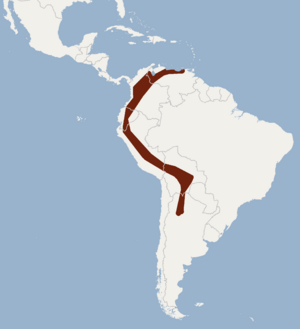Hairy yellow-shouldered bat facts for kids
Quick facts for kids Hairy yellow-shouldered bat |
|
|---|---|
| Conservation status | |
| Scientific classification | |
| Genus: |
Sturnira
|
| Species: |
erythromos
|
 |
|
The hairy yellow-shouldered bat (Sturnira erythromos) is a type of bat found in South America. It belongs to a group of bats called Phyllostomidae. This bat does not have any known subspecies, meaning there are no different types of this bat.
Contents
About the Hairy Yellow-Shouldered Bat
This bat is quite small. It is usually about 5.5 cm (2.2 in) long, which is shorter than a typical smartphone. It weighs around 16 g (0.56 oz), which is like a few coins. The bat's body is covered in soft, dark brown fur, and its wings are almost black. Even though it's called "yellow-shouldered," most of these bats do not actually have yellow fur on their shoulders. Their shoulders are usually the same dark color as the rest of their body. This bat has a short snout with very little hair and a round head. It also has a dark patch of fur on its forehead.
Wings and Other Features
The hairy yellow-shouldered bat has long, wide, and pointed wings. It has almost no uropatagium, which is the skin membrane between a bat's legs. This bat also does not have a tail. Most other bats have small spurs on their legs that help support this membrane, but the hairy yellow-shouldered bat does not have them. Its ears are short and round, and its eyes are large. The bat's nose-leaf is simple, being wide and short. The "horseshoe" shape, common in its bat family, is joined to its upper lip. A single row of whiskers grows from a pad around its nose-leaf.
Where Hairy Yellow-Shouldered Bats Live
Hairy yellow-shouldered bats live in the Andes mountains. You can find them from northern Argentina all the way to Venezuela. They mostly live in tropical cloud forests and high-altitude rain forests. Sometimes, they can also be found in drier forests or mountain grasslands during certain times of the year. In Argentina, they can live at lower altitudes. However, in most other places, they are found between 1,135 and 3,500 m (3,724 and 11,483 ft) high. The closer they are to the equator, the higher up in the mountains they tend to live.
Life and Habits of the Bat
Hairy yellow-shouldered bats are frugivores, which means they mostly eat fruit. Their favorite foods are the fruits from pepper plants and different types of Solanum plants. These bats are nocturnal, meaning they are active at night. During the day, they rest and sleep in hollow trees.
Adaptations and Reproduction
Compared to other bats that live in warm, tropical areas, these bats are good at living in cooler climates. They can lower their body temperature when the air temperature drops below 25 °C (77 °F). This helps them save energy. In Argentina, the breeding season for these bats starts in July. The young bats are born between November and January. A mother bat usually gives birth to only one baby at a time.
See also
 In Spanish: Sturnira erythromos para niños
In Spanish: Sturnira erythromos para niños


